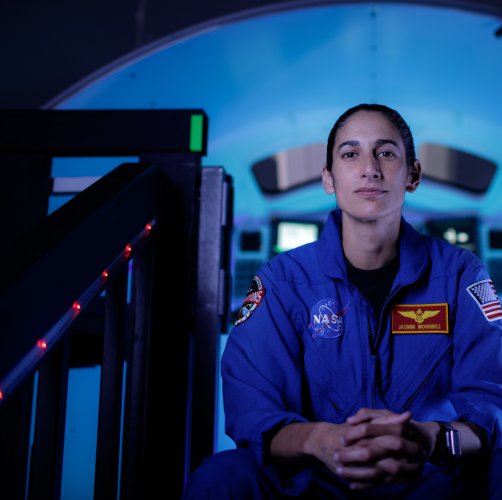1 of 6 | The members of the 2021 NASA astronaut class are (from left to right): Nichole Ayers, Christopher Williams, Luke Delaney, Jessica Wittner, Anil Menon, Marcos Berríos, Jack Hathaway, Christina Birch, Deniz Burnham, and Andre Douglas. Photo courtesy of NASA
Dec. 6 (UPI) -- NASA announced 10 astronaut candidates Monday near Johnson Space Center in Houston -- six men and four women -- who someday may walk on the moon.
The prospective astronauts, named during ceremonies at Ellington Field, range in age from 32 to 45. They are to undergo about two years of training, after which they could be eligible for flights to the International Space Station, the moon or even Mars.
However, those who will fly to the moon initially -- including the first woman to walk on its surface -- very likely would come from the existing 44-member astronaut corps because of greater experience and training, officials have said. Of those, 16 are women.
NASA made the new selections after reviewing 12,000 applications. The last such announcement came in 2017, when the agency named 12 astronaut candidates.
Those selected Monday are to report to Johnson Space Center in January "to begin their training in spacecraft systems, spacewalking skills, teamwork and other necessary skills," according a NASA press release.
The astronaut candidates are:
- Nichole Ayers, 32, of Colorado, a major and combat aviator in the U.S. Air Force.
- Marcos Berríos, 37, who grew up in Puerto Rico, a major in the U.S. Air Force and a helicopter test pilot.
- Christina Birch, 35, originally from Arizona, a biological engineer who has been a track cyclist on the U.S. National Team.
- Deniz Burnham, 36, a drilling engineer from Alaska, with the rank of lieutenant in the U.S. Navy.
- Luke Delaney, 42, who retired from the U.S. Marine Corps as a test pilot, from central Florida.
- Andre Douglas, 35, a former naval architect with the U.S. Coast Guard from Virginia.
- Jack Hathaway, 39, commander and aviator with the U.S. Navy, from Connecticut.
- Anil Menon, 45, a lieutenant colonel with the U.S. Air Force raised in Minnesota, who was SpaceX's first flight surgeon.
- Christopher Williams, 38, a medical physicist who grew up in Maryland.
- Jessica Wittner, 38, a native Californian and lieutenant commander and aviator with the U.S. Navy.
NASA Administrator Bill Nelson praised the new candidates during the ceremony.
"You've been selected not only to push the envelope of humanity's potential, you've been tasked to carry out the hopes of a nation -- and that hope is found in the twinkling eyes of a child with a dream of soaring upwards," Nelson said.
As he spoke, thunder clapped over the Houston area, which he said was "the voice of God."
NASA raised the requirements for applicants for the new class. To be eligible, candidates must have a master's degree in science, math or another technical field, rather than just a bachelor's degree.
The requirement for a master's degree can be met in other ways, such as having a medical degree or completing a nationally recognized test pilot school program.
NASA officials told UPI in 2020 that the space agency has no set number of candidates, no set number of spots to fill or any predetermined breakdown by gender or other attributes.
In 2017, the space agency received more than 18,000 applications -- three times the previous number in 2012 and surpassing a then-record 8,000 applicants in 1978.
Jasmin Moghbeli
Moghbeli poses for a portrait in the Systems Engineering Simulator for the International Space Station and advanced spaceflight programs at the Johnson Space Center on July 9, 2019. She will train for the moon mission. Photo by Bill Ingalls/NASA
















